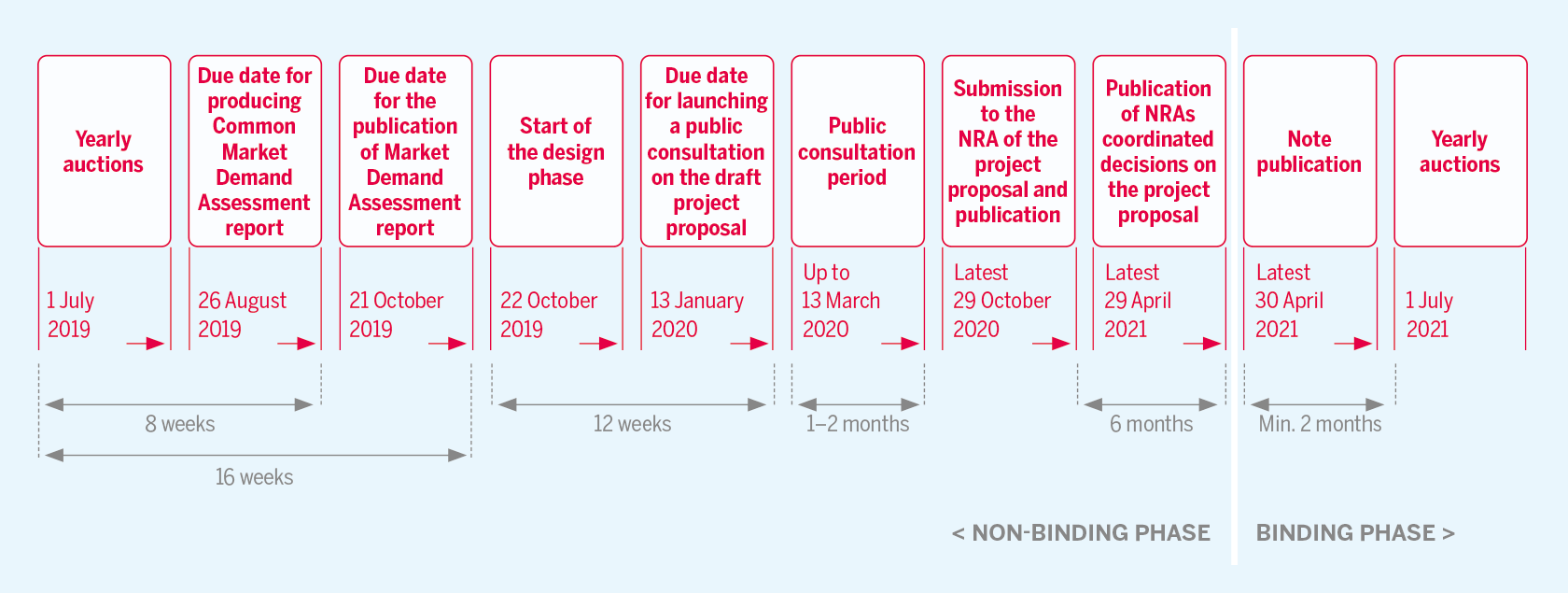7.1Description of the incremental capacity process
The incremental capacity process has been introduced by the Commission Regulation (EU) 2017/4591 for a streamlined and harmonised Union-wide process to react to possible market-based capacity requests for an increase in technical capacity or creation of new capacity. The requested incremental capacity may be offered based on market demand. Building the capacity is based on binding market commitments and subject to the positive outcome of an economic test, in the following cases:
- At existing interconnection points (IPs);
- When establishing a new IP;
- With physical reverse flow capacity at an IP, which has not been offered before.
The aim of setting rules for incremental capacity is to identify the need for new/incremental capacity and to allocate both existing and incremental capacity in an integrated way.
This process lasts two years and is divided in two phases, a non-binding phase in which the demand for incremental capacity is assessed, and a binding phase where network users provide binding commitments for incremental capacity.
The non-binding phase starts after the annual yearly auction, at least in each odd-numbered year, with the assessment of demand indications for incremental capacity. The network users provide TSOs with their non-binding capacity demand (with regards to volume, direction, duration, location of their interest) including possible conditionality and other relevant documentation. No later than 8 weeks after the start of the annual yearly auction, TSOs shall produce market demand assessment reports (DARs) which shall be published within 16 weeks after the start of the annual yearly auction. The DARs should consider, among other things, whether the TYNDP identifies a physical capacity gap whereby a specific region is undersupplied in a reasonable peak scenario and where offering incremental capacity at the interconnection point in question could close the gap; or a national network development plan identifies a concrete and sustained physical transport requirement. If the DAR identifies demand for incremental capacity that cannot be satisfied by existing available capacity, the concerned TSOs will follow the incremental capacity process further. If no demand has been identified, the process stops here.
In the next phase, the design phase, TSOs conduct technical studies for incremental capacity projects and coordinated offer levels based on technical feasibility and the DARs. No later than 12 weeks after the start of the design phase, a public consultation on the key parts of the draft project proposal is conducted and stakeholders have an opportunity to provide feedback on the TSOs’ proposals. A key milestone after the design phase and public consultation is to submit a comprehensive incremental capacity project proposal to the relevant National Regulatory Authorities (NRAs). The NRAs will then have 6 months to issue coordinated decisions on the project proposal.
After the NRAs’ decisions, the binding allocation phase will start and binding commitments for incremental capacity from network users will be collected during the annual yearly auction. As a default, auctions are used. However, an alternative capacity allocation mechanism can be employed, subject to NRA’s approval, where the market demand assessment shows that the ascending clock auction is not suitable and that the incremental capacity project fulfils both of the following conditions: (a) the incremental project involves more than two entry-exit systems and bids are requested along several interconnection points during the allocation procedure; and (b) bids with a duration of more than 1 year are requested.
After receiving binding commitments for the incremental capacity offered in the annual yearly auction, the economic viability of the incremental capacity project will be assessed trough the economic test. If the outcome of the economic test is positive on both sides of an interconnection point for at least one offer level that includes incremental capacity, an incremental capacity project will be initiated.
1 COMMISSION REGULATION (EU) 2017/459 of 16 March 2017 establishing a network code on capacity allocation mechanisms in gas transmission systems and repealing Regulation (EU) No 984/2013
7.2First incremental capacity process initiated in 2017
The first incremental capacity process was initiated in April 2017 following Chapter 5 (Articles 22 to 31) of the Capacity Allocation Mechanisms Network Code (CAM NC).
In order to analyze the progress of the incremental capacity process and to identify if new capacity projects were going to be initiated as a result of the incremental capacity process, data from 38 out of 44 ENTSOG members was collected. Based on that data and further interactions with the TSOs, a report on the first incremental capacity process2 was produced and published. Additional information on the incremental process can be also found in the annexes, especially in annex 23 which contains the responses of the TSOs to the questionnaire launched.
Figure 37 is a summary of the results of the first incremental process which shows the number of TSOs involved during the different steps of the incremental capacity process as well as the outcome of each phase.
The initial step in the incremental capacity process is for the TSOs to perform common DARs at each entry-exit border based on the non-binding demand received by network users. The DARs for the first incremental capacity process are available at ENTSOG webpage4. On those cases in which a demand for incremental capacity was identified in the DARs, the respective TSOs continued with the incremental capacity process. Table 7 refers to those projects and provides information on the entry-exit borders covered by them, the TSOs involved, the specific TYNDP reference number for the projects that were included in the 2018 TYNDP and informs whether the different steps of the incremental capacity process were performed or not.
2 https://www.entsog.eu/sites/default/files/2020-01/entsog_incremental_capacity_report_2017_lux version.pdf
3 https://www.entsog.eu/sites/default/files/2020-01/Annex 2 – Incremental monitoring responses_final.xlsx
4 https://www.entsog.eu/capacity-allocation-mechanisms-nc#incremental-capacity-demand-assessment-2017
Market demand assessment
38 ENTSOG members published DARs in 2017
Design phase
16 TSOs conducted technical studies for one or more entry-exit border and joint public consultions (but not for all these borders)
22 TSOs concluded after the DAR that the incremental project shall not be intiated
Approval and publication of incremental capacity projects
12 TSOs submitted the project proposal to the relevant NRAs and published it
2 TSOs flowed the incremental capacity process 2017 into the 2019 incremental cycle while 2 TSOs did not follow further the incremental capacity process
Auctioning of incremental capacity
4 TSOs offered incremental capacity for 15 years per offer level during the yearly auction 2018 while 5 TSOs during 2019
Alternative allocation mechanism
2 TSOs* have proposed an alternative allocation mechanism
Alternative allocation mechanism
4 TSOs** did not proceed with the process because no coordinated decisions were reached previously by NRAs
Economic test
None of the 9 TSOs who auctioned incremental capacity received binding commitments
Conclusion
No incremental projects are going to be initiated at this stage
* 1 of the TSOs who proposed an alternative allocation mechanism for one of their entry-exit borders, offered incremental capacity for other entry-exit border.
** 2 of the TSOs who did not follow further the incremental capacity process for one of their entry-exit borders, auctioned incremental capacity for other entry-exit border.
Figure 37: Summary of the results of the first incremental process
| TYNDP 2018 reference number | Entry-exit border | TSO(s) involved that reported the progress of the Incremental Capacity Process | Performance of technical studies | Launch of a public consultation | Submission of the project proposal to the NRA | Publication of coordinated decisions by the NRAs | Yearly auctions for incremental capacity | Economic test |
|---|---|---|---|---|---|---|---|---|
| Project not included | AT – SK | GCA | on the Austrian side there was enough technical capacity available | Alternative allocation mechanism | Not performed because binding commitments were not received from network users | |||
| Project not included | SK – AT | Eustream | Alternative allocation mechanism | Not performed because binding commitments were not received from network users | ||||
| Project not included | DE – AT | Bayernets, GRTgaz Deutschland, OGE | Yearly auction 2018 | Not performed because binding commitments were not received from network users | ||||
| Project not included | AT – DE | GCA | Yearly auction 2018 | Not performed because binding commitments were not received from network users | ||||
| Project not included | GR – IT | DESFA | The incremental capacity process 2017 flowed into the 2019 incremental cycle | |||||
| TRA-N-1246 | IT – GR | SNAM | The incremental capacity process 2017 flowed into the 2019 incremental cycle | |||||
| Project not included | AT – SL | GCA | Not performed because binding commitments were not received from network users | |||||
| TRA-N-873 | DE – NL | Gascade, Gasunie Deutschland | Yearly auction 2019 | Not performed because binding commitments were not received from network users | ||||
| Project not included | NL – DE | Gasunie Transport Services | Yearly auction 2019 | Not performed because binding commitments were not received from network users | ||||
| Project not included | DE – Russian Federation | Gascade, Gasunie Deutschland, NEL, Ontras | Not performed because NRA rejected the project proposal. | |||||
| Project not included | AT – CZ | GCA | The BACI project covered all the demand indicated by the network users |
|||||
| TRA-N-423 | AT – HU | GCA | ACER decision No 05/2019 * | The yearly auction was completed in July 2020 |
||||
| Project not included | HU – AT | FGSZ | ACER decision No 05/2019 | The yearly auction was completed in July 2020 |
||||
| TRA-N-1202 | PL – DE | GAZ-SYSTEM | ACER decision No 13/2019** |
|||||
| Project not included | DE – PL | Ontras | ACER decision No 13/2019 |
|||||
| TRA-N-86 | HR – SL | Plinacro | The process itself was non-binding and the received non-binding feedback was small. Physical flow from Croatia to Slovenia had to be enabled on 1st January 2019 regardless the incremental process due to the obligation of stablishing reverse flow in accordance with regulation 2017/1938 (security of supply) |
|||||
| TRA-N-390 | SL – HR | Plinovodi | The process itself was non-binding and the received non-binding feedback was small. Physical flow from Croatia to Slovenia had to be enabled on 1st January 2019 regardless the incremental process due to the obligation of stablishing reverse flow in accordance with regulation 2017/1938 (security of supply) |
|||||
| Project not included | SL – IT | Plinovodi | No joint consultation was conducted for the border between Italy and Slovenia as only Plinovodi received non-binding indications |
|||||
| TRA-F-1235 | HU – SK | MGT (now FGSZ) | Performed on HU side with SK assistance | Alternative allocation mechanism. | Performed but with no binding commitments received from network user. |
|||
| TRA-F-1235 | SK – HU | EUSTREAM | SK assistance to the HU partner | Alternative allocation mechanism. | Performed but with no binding commitments received from network user. |
|||
* Because of the absence of an agreement between the involved NRAs, ACER became the competent authority to decide on this matter and issued the decision No 05/2019 where the parameters of the economic test were defined and it was concluded that the TSOs should continue with the incremental capacity process by marketing the incremental capacity at two offer levels. This decision was appealed. However, the Board of Appeal of ACER dismissed the appeal against the Contested Decision as partly inadmissible and unfounded. The Board of Appeal decision was also appealed to the ECJ. The ECJ case is still pending for a final resolution.
**ACER found the application for an approval of the incremental capacity project for the market border of Poland (E-Gas Transmission System) and GASPOOL as inadmissible. This is due to the absence of an operational prerequisite for implementing the incremental capacity project related to the joint capacity booking platform. Additionally, the project has become obsolete after being supersede by a new incremental cycle.
Table 7: Projects for which a demand for incremental capacity was identified in the DARs
During the annual yearly auctions, the TSOs who offered incremental capacity did not received any binding commitments from network users. This fact implied that there was no need to determine the economic viability for these projects and therefore no individual economic tests nor single economic tests were carried out.
Consequently, there were no proposals of redistribution of revenues for any of the TSOs. Therefore, the report on the first incremental capacity process concluded that no incremental capacity projects were going to be started at that point.
7.3Incremental capacity process initiated in 2019
Immediately after the start of the annual yearly capacity auctions in July 2019, a new cycle of the incremental capacity process was initiated. Figure 38 illustrates the timeline for this process, according to the time periods stipulated in the CAM NC, which shows that at the time of publication of the TYNDP 2020, TSOs should be in the stage of submitting their project proposals for an incremental capacity project to the relevant NRAs for coordinated approvals.
This means that the previous steps of the process, which include the collection of non-binding demands, development of DARs, conduction of technical studies for incremental capacity projects and conduction of a public consultation on the draft project proposal should be finalised by this time.
Figure 38: Timeline for the incremental capacity process initiated in 2019
As for the incremental capacity process initiated in 2017, the beginning of the process for 2019 has been marked by the development and publication of the DARs which are available at ENTSOG webpage5 together with a summary table6. In this initial step, network users had the option to send non-binding demand indications for incremental capacity at interconnection points to the TSOs. These demand indications were collected and evaluated by the TSOs, the results of which are described in the DARs together with the provisional timelines for the incremental capacity projects. These reports also contemplate whether technical studies of incremental capacity projects are going to be initiated and if is the case, an assessment of the expected amount, direction and duration of demand for incremental capacity at the affected interconnection points is undertaken.
No later than 12 weeks after the start of the design phase, the concerned TSOs had to conduct joint public consultations on the draft project proposals which covered at least the elements listed in Article 27(3) of the CAM NC. Information and links to the public consultations are available in the table7 published at ENTSOG webpage.
For TYNDP 2020 ENTSOG collected information regarding projects triggered by the Incremental Capacity process. For the purpose of TYNDP 2020 the provision of such information was mandatory.
It is to be mentioned that the TYNDP 2020 project data collection took place in June 2019 i. e. before the Demand Assessment Reports related to the Incremental Capacity 2019 have been published.
As such, all TYNDP 2018 projects listed in table 7 above have been submitted for TYNDP 2020 as well.
In addition to these projects, 1 project submitted to TYNDP 2020 in October 2019 indicated as being a result of the demand assessment in the context of the 2019 Incremental Capacity process. The concerned project is TRA-N-810, TAP Expansion and the related Demand Assessment Report was published on 21 October 2019 by TAP. It indicates that TAP will proceed to the coordinated design phase and to investigate an expansion of TAP up to Total Capacity of TAP of 20 BCMA8.
5 https://www.entsog.eu/capacity-allocation-mechanisms-nc#incremental-capacity-demand-assessment-2019
6 https://www.entsog.eu/sites/default/files/2020-04/MC0099-19_Demand Assessment Reports summary_updated.xlsx
7 https://www.entsog.eu/capacity-allocation-mechanisms-nc#incremental-capacity-process-2019-joint-consultation
8 https://www.tap-ag.com/assets/07.reference_documents/english/Market%20Test/Demand%20Assessment_TAP_DESFA_SNAM_28%2010%202019_revised_topublish.pdf


